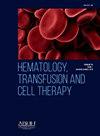金(i)基复合audmap:一种有前途的黑色素瘤治疗抗增殖剂
IF 1.8
Q3 HEMATOLOGY
引用次数: 0
摘要
黑色素瘤是最具侵袭性的皮肤癌类型,全球发病率不断上升。以铂为基础的化疗,特别是顺铂,仍然是一种标准治疗方法,但其有效性往往受到耐药性和严重副作用的限制。金基配合物由于其更大的化学稳定性、对铂耐药细胞的选择性细胞毒性、较低的全身毒性和免疫调节作用,作为潜在的替代品而受到关注。我们小组之前的研究表明,AuDMAP(一种金(I)基复合物)在UACC-62黑色素瘤细胞系中具有抗增殖活性。基于这些发现,本研究探讨了AuDMAP在SK-MEL-28和A-375黑色素瘤细胞中的抗增殖作用、细胞毒性和选择性,以及与顺铂相比,其对细胞迁移和潜在抗转移特性的影响。目的评价AuDMAP复合物对SK-MEL-28和A-375黑色素瘤细胞系的抗增殖活性和细胞死亡机制,并确定其对非肿瘤HaCaT细胞的毒性。材料与方法将肿瘤细胞和非肿瘤细胞在DMEM + 10% FBS + 1%青霉素-链霉素中培养,用AuDMAP(0.78-100µM)处理48h,以顺铂为对照。采用硫代丹胺B (SRB)和噻唑蓝溴化四唑铵(MTT)测定细胞活力、抗增殖活性和IC50值。伤口愈合试验评估迁移,流式细胞术将用于探索细胞死亡机制和细胞周期效应。结果:audmap显示出很强的抗增殖活性,在6.25µM时抑制黑色素瘤细胞增殖~ 80%,比顺铂对SK-MEL-28和A-375的效果分别高15倍和3.3倍。IC50值分别为2.61µM (SK-MEL-28)、2.50µM (a -375)和1.81µM (HaCaT),选择性指数较低(0.69 ~ 0.72)。迁移实验显示,AuDMAP显著减少了伤口愈合,表明其具有抗转移潜力。在A-375中,AuDMAP的伤口愈合率为-8.5%,顺铂(6.25µM)为62.8%,而SK-MEL-28的伤口愈合率分别为4.6%和-13.5%。鉴于这些有希望的结果,进一步的研究将集中在细胞周期分析和死亡机制上,以更好地了解AuDMAP的生物学效应。结论audmap是一种金(I)基复合物,在黑色素瘤细胞中显示出强大的抗增殖和抗迁移作用,在实验模型中疗效明显优于顺铂。对细胞增殖和迁移的抑制表明其作为一种有前途的抗癌药物的潜力,可能破坏肿瘤的进展和转移。然而,观察到的低选择性指数表明其细胞毒性作用延伸到非肿瘤细胞,引起了对静脉给药安全性的担忧。为了进一步探索其治疗可行性,未来的研究将在分子水平上研究其作用机制,重点关注细胞周期调节和程序性细胞死亡途径。这些发现促进了人们对金(I)化合物作为黑色素瘤治疗的新候选药物的兴趣,特别是局部给药。本研究得到巴西机构FAPESP(2021/10265-8癌症治疗创新中心- CEPID)和坎皮纳斯大学Program (PPPD) (UNICAMP, ID号325141)的资助。本文章由计算机程序翻译,如有差异,请以英文原文为准。
GOLD(I)-BASED COMPLEX AUDMAP: A PROMISING ANTIPROLIFERATIVE AGENT FOR MELANOMA TREATMENT
Introduction/Justification
Melanoma is the most aggressive type of skin cancer, with increasing global incidence. Platinum-based chemotherapy, particularly cisplatin, remains a standard treatment, but its effectiveness is often limited by drug resistance and severe side effects. Gold-based complexes have gained attention as potential alternatives due to their greater chemical stability, selective cytotoxicity against platinum-resistant cells, lower systemic toxicity, and immunomodulatory effects. Previous studies from our group demonstrated the antiproliferative activity of AuDMAP, a gold(I)-based complex, in the UACC-62 melanoma cell line. Building on these findings, this study investigates the antiproliferative effects, cytotoxicity, and selectivity of AuDMAP in SK-MEL-28 and A-375 melanoma cells, as well as its impact on cell migration and potential anti-metastatic properties in comparison to cisplatin.
Objectives
To evaluate the antiproliferative activity and cell death mechanisms induced by the AuDMAP complex in SK-MEL-28 and A-375 melanoma cell lines, as well as determining its toxicity against non-tumoral HaCaT cells.
Materials and Methods
Melanoma and non-tumor cells were cultured in DMEM + 10% FBS + 1% penicillin-streptomycin and treated with AuDMAP (0.78–100 µM) for 48h, with cisplatin as a control. Sulforhodamine B (SRB) and Thiazolyl Blue Tetrazolium Bromide (MTT) assays were performed to determine cell viability, antiproliferative activity, and IC50 values. The wound healing assay assessed migration, and flow cytometry will be conducted to explore cell death mechanisms and cell cycle effects.
Results
AuDMAP exhibited strong antiproliferative activity, inhibiting ∼80% of cell proliferation at 6.25 µM in melanoma cells - 15x more effective than cisplatin for SK-MEL-28 and 3.3x for A-375. IC50 values were 2.61 µM (SK-MEL-28), 2.50 µM (A-375), and 1.81 µM (HaCaT), yielding a low Selectivity Index (0.69–0.72). Migration assays revealed that AuDMAP significantly reduced wound closure, suggesting anti-metastatic potential. In A-375, wound closure was -8.5% with AuDMAP vs. 62.8% with cisplatin (6.25 µM), while in SK-MEL-28, closure was 4.6% vs. -13.5%, respectively. Given these promising results, further studies will focus on cell cycle analysis and death mechanisms to better understand the biological effects of AuDMAP.
Conclusion
AuDMAP is a gold(I)-based complex that demonstrates potent antiproliferative and anti-migratory effects in melanoma cells, with efficacy significantly superior to cisplatin in the tested models. The inhibition of cell proliferation and migration suggests its potential as a promising anticancer agent, possibly disrupting tumor progression and metastasis. However, the low selectivity index observed indicates that its cytotoxic effects extend to non-tumor cells, raising concerns about the safety profile in intravenous administration. To further explore its therapeutic viability, future studies will investigate its mechanisms of action at the molecular level, focusing on cell cycle modulation and programmed cell death pathways. These findings contribute to the growing interest in gold(I) compounds as novel candidates for melanoma treatment, particularly for topical administration.
Acknowledgements
This study was supported by grants from the Brazilian Agencies FAPESP (2021/10265-8 Cancer Theranostics Innovation Center - CEPID), and Program (PPPD) at the University of Campinas (UNICAMP, ID Number 325141).
求助全文
通过发布文献求助,成功后即可免费获取论文全文。
去求助
来源期刊

Hematology, Transfusion and Cell Therapy
Multiple-
CiteScore
2.40
自引率
4.80%
发文量
1419
审稿时长
30 weeks
 求助内容:
求助内容: 应助结果提醒方式:
应助结果提醒方式:


